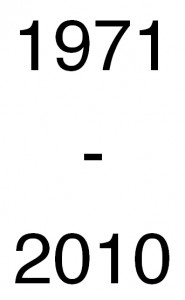 The 40th annual Society for Neuroscience meeting is about to begin. This fact merits some reflection. 40 large meetings – held consecutively year after year – suggest a wildly successful, long and unbroken chain of vigorous scientific exchange. As such, it is certainly grounds for celebration. Scientific societies tend to have a number of core objectives. These typically include the fostering of interactions among members as well as public advocacy. SfN is no exception. The Society fosters scientific communication in various ways. One of the them is the publication of the Journal of Neuroscience every week, another is the hosting of the annual meeting. Why is this remarkable? The Society was founded relatively recently – in 1969. This is very late by the standards of learned societies. For instance, the Royal Society was founded in 1660, the American Physiological Society in 1887 and the American Psychological Association in 1892. Yet, the Society for Neuroscience already has over 40,000 members. As a matter of fact, having flourishing societies, journals and conferences are markers that Neuroscience has established itself as a distinct discipline (completed “Disziplingenese“, as we say) in its own right.
The 40th annual Society for Neuroscience meeting is about to begin. This fact merits some reflection. 40 large meetings – held consecutively year after year – suggest a wildly successful, long and unbroken chain of vigorous scientific exchange. As such, it is certainly grounds for celebration. Scientific societies tend to have a number of core objectives. These typically include the fostering of interactions among members as well as public advocacy. SfN is no exception. The Society fosters scientific communication in various ways. One of the them is the publication of the Journal of Neuroscience every week, another is the hosting of the annual meeting. Why is this remarkable? The Society was founded relatively recently – in 1969. This is very late by the standards of learned societies. For instance, the Royal Society was founded in 1660, the American Physiological Society in 1887 and the American Psychological Association in 1892. Yet, the Society for Neuroscience already has over 40,000 members. As a matter of fact, having flourishing societies, journals and conferences are markers that Neuroscience has established itself as a distinct discipline (completed “Disziplingenese“, as we say) in its own right.
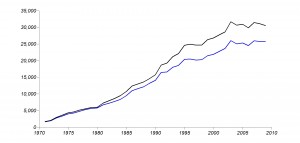
Meeting attendance over the years. Black: Total attendance. Blue: Scientific attendance. Values have been averaged over 3 years to smooth out yearly fluctuations in funding and attractiveness of venue.
Everything indicates that the meeting itself has come of age as well. This is particularly true for the last five to ten years, when the meeting seems to have reached “steady state” (see figures). One thing is for sure: There are now plenty of people at a typical meeting, but the growth seems to have leveled off. It will be interesting to see how these numbers develop in the future.
Attendance is not the only variable of interest when it comes to SfN. Another important parameter is the venue. These are not equally or randomly distributed across the globe. All but one of the host cities (Toronto, 1976 and 1988) has been in the US. But the distribution is not even within the US,
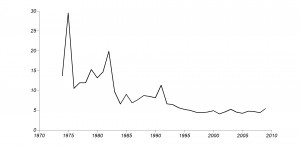
Ratio of Scientific vs. Nonscientific (e.g. vendors) attendance at past SfN meetings. Meetings without non-scientific attendance are not reflected here.
either. Only 17 US cities (plus Toronto) have been host to a SfN meeting. At this point, SfN is so large that only about 8 cities in the US have the physical facilities to host a meeting of this magnitude. But as the figures bear out, this has not been the case historically. Something else is going on. While it has been suggested that average intelligence (IQ) is inversely related to the average temperature in a state (ASSOCIATIONS BETWEEN CLIMATE AND IQ IN THE UNITED STATES OF AMERICA), warmth certainly seems to attract SfN meetings (see figure). I haven’t run the correlation, but I expect it to be both strong and significant. Note: I understand that intelligence is a controversial subject. This one should give you food for thought: No correlation between author IQ and number of citations.
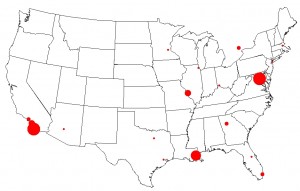
All SfN host cities, 1971-2010. Size of the red dot reflects number of hostings, from 1 (e.g. Chicago) to 6 (e.g. San Diego).
Let us briefly return to the 40 SfN meetings. It doesn’t sound like much, but if you have attended every single one (and I suspect I know some individuals who have), you have spent a cumulative 6 months at the meeting (assuming a constant meeting duration over the years). I think the Society should honor these hardy veterans with a special medal (an “Iron poster” might be apt?). In any case, by now the SfN meeting has established itself as the typical “fall” meeting. Personally, I complement this with a smaller, specialized meeting in the spring. If I feel particularly indulgent in a given year, I will throw in a summer one too, to round off the annual meeting schedule.
The most seminal paper on the SfN meeting is probably this one. A brief summary (most of the findings are not all that surprising, but the paper does make for an illuminating read): 1. The New York Juggernaut: Every year out of the 6 that they looked at, authors from the New York region were most numerous, in terms of raw numbers of abstracts. The second place rotated between the – perhaps more obvious – Boston, Bethesda and Baltimore. On average, close to 3% of all SfN abstracts come from New York (in line with expectations from population size). 2. The usual suspects: Per capita top representation rotates between Ann Arbor, New Haven and Cambridge, MA (surprise). 3. The power of convenience. If the meeting is physically close, researchers within a 100 mile radius are much more likely to submit an abstract than when the meeting is held somewhere else. This effect dissipates with as spatial distance increases. 4. Global reach. SfN abstract authors hail from all continents expect Antarctica, with – currently – a heavy overrepresentation of authors from the US, Western Europe and Japan. 5. Collaboration is key. On average, there are just over 4 authors per abstract and between 2001 and 2006, just shy of 3 abstracts per author. 6. The mode is 1. Attendance seems to be exponentially distributed, with most authors attending only once in a 6 year span, and very few people attending every year. 7. There are multiple meetings going on at the same time. Not surprisingly, abstract contents cluster around a few relatively distinct topics. For instance, “Substance Abuse and Addiction”, “Protein Expression”, “Visual and Motor systems”. But there are also some small and distinct communities that focus on a sharply delineated issue, such as “Sleep”, “Alzheimer’s disease” or “Birdsong”. There are many distinct meetings going on at the same time. 8. The meeting is thematically dynamic. From 2001 to 2006, the “Visual and Motor” cluster shows a consistent increase (from 14% to 18% of abstracts) whereas cellular neuroscience shows a consistent decrease in representation (28% to 23%). It would be interesting to see where they are now. 9. Surprise? Most decreasing abstract words: “Receptor”, “cell”. Most increasing ones: “Behavior”, “model”. 10. Funding matters. Overall, most abstracts are funded by NINDS and NIMH. Most institutes seem to fund within their mission. That is the gist that I took from the paper. But see for yourself.
Despite all these numbers, the number of the day has to be 125. That is the number of “academic spam” emails that I have received (thus far) in regards to the SfN 2010 meeting. I don’t mind the efforts of the vendors. Really, I don’t. What I do mind is the indiscriminate approach, the untargeted nature of the efforts. That cannot be efficient for anyone. Take this one, for example (see figure). I received it today and it makes a case in point. I am sure this apparatus is the bee’s knees in the field, and if I would have any need to refrigerate mouse urine at very low temperatures, I would probably use it. But – for better or for worse, I do not currently have this need, nor do I see it arising in the foreseeable future… That’s it for today. I’m looking forward to seeing you on the other side…

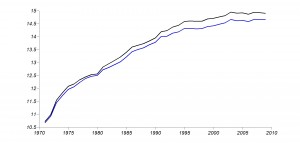
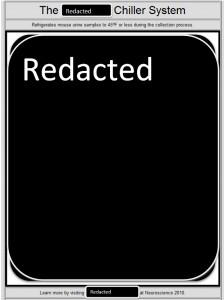
And this year, the inaugural meeting of the Society for Social Neuroscience (S4SN.org) will take place here in San Diego, on November 12. This new society has already 1340 members.
Here is the information for the meeting:
http://s4sn.org/drupal/?q=node/3
Pingback: Showtime! | Pascal's Pensées
Lieber Pascal,
herzlichen Glueckwunsch zu dieser schoenen Analyse.
Viel glueck weiterhin,
Hartmut Schulz
Pingback: What is the true cost of attending SfN? | Pascal's Pensées